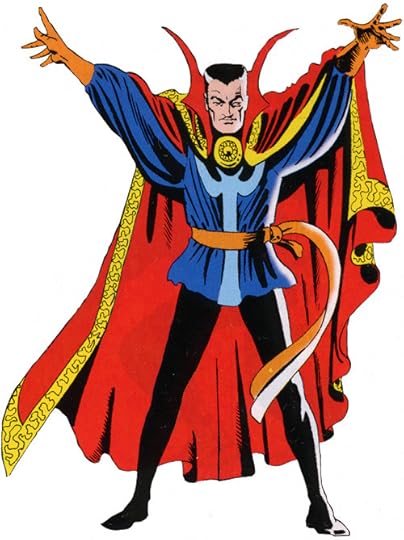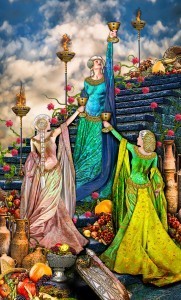Llewellyn Publications's Blog, page 87
June 11, 2013
Gurus in the Garden: Communicating with Flowers
Readers, please enjoy this guest blog post by Tess Whitehurst, author of The Art of Bliss, The Good Energy Book, Magical Housekeeping, and the new Magic of Flowers.
One of my very favorite things to do is visit Descanso Gardens, an amazing botanical wonderland nestled way out on the edge of Los Angeles where the city gives way to the foothills. For  me, it’s not just about ooh-ing and aah-ing at the pure physical beauty of the tulips and camellias (or whatever happens to be in bloom), although that’s part of it. It’s more like a spiritual pilgrimage to visit the wisest sages I know, all of whom are more than generous with their wisdom and healing abilities. The only prerequisite is that I sit quietly, listen, and be open to receive.
me, it’s not just about ooh-ing and aah-ing at the pure physical beauty of the tulips and camellias (or whatever happens to be in bloom), although that’s part of it. It’s more like a spiritual pilgrimage to visit the wisest sages I know, all of whom are more than generous with their wisdom and healing abilities. The only prerequisite is that I sit quietly, listen, and be open to receive.
How to Talk to a Flower
When I have what I call a “conversation” with a flower (but what might more accurately be called a “session”), I begin by sitting or standing comfortably in close proximity to it. While gazing at the blossom, I consciously relax my body and become aware of my breath, allowing it to naturally deepen. When the time feels right, I might silently ask something of the flower, like, “How can I relieve stress?”, “How can I gain clarity (on a certain situation)?”, or, more frequently, “What wisdom or healing would you like to share?” I ask these questions not simply with silent words, but with my heart and feelings. Then, I continue to relax and gaze at the flower. In time, feelings and thoughts begin to emerge within me, which I identify as communications or responses from the blossom. Perhaps I feel a warmth in my belly or an opening in my heart, or perhaps I see a picture of myself spending more time in nature or drinking less coffee. Sometimes I will bring a notebook along and translate the information into words, so that it’s almost like I’m receiving dictation.
A Tiny Sampling of Flower Wisdom and Healing
In The Magic of Flowers, I relate a lot of the wisdom and magic I’ve received from blossoms, but below you’ll find a brief sampling of some of what they’ve had to share. (Although, of course, you don’t have to take my word for it—the flowers would love to commune with you as well!)
Iris is a master energy healer. She’s excellent at balancing the subtle energy patterns throughout the body, aura, and chakras.
Morning glory says, “Relax! You are one with All That Is, so why worry? Why struggle? Why rush? Relax into your true nature, into the arms of the Divine.”
Cherry plum supports digestion, circulation, and overall energy levels.
Lantana helps with depression by jump-starting your emotional flow.
Bleeding heart says, “Don’t fight your old pain and heartache! Relax and breathe into it. Let it be what it is. Send love to it continually until it naturally begins to disperse.”
Orchid reminds us to express our uniqueness and to know that we are beautiful and elegant exactly as we are.
Our thanks to Tess for her guest post! For more from Tess Whitehurst, read her article “Seven Flower Magic Rituals.”
Real Magick and Dr. Strange
When I was a kid I loved comic books. I quickly got bored with Superman because he had no weaknesses except Kryptonite, and you couldn’t have him deal with a green, red, or another color of alien rock every issue. As to the other comics from the company that published Superman, well, I remember reading the first Justice League of America story where all of their leading superheroes had to join forces to defeat…a giant starfish!
No, really!
And then I discovered comics from Marvel. Spiderman was a kid not much older than me, and he had all the problems and issues I faced (along with his spidey sense and super powers thing). I really liked Thor, too. Here was a guy who was in love with a woman but was too shy to say anything because he had a physical handicap. She loved him, too, and kept waiting for him to say something. Eventually, he finds a stick that turns him into a virtual God when he taps it on the ground. This was every schoolboy’s dream! If you were beat up by bullies or felt insecure (who didn’t?) you could just tap a stick and become a hero so handsome everyone would fall in love with you. Whatta guy! [It caused me to go to my school library and the local public library to find out more on the traditional Thor, but neither had much on him. There was plenty on the Greek and Roman myths, but in those books the Norse myths were minor appendices. Grrr.]
And then came Dr. Stephen Strange. A brilliant but egotistical and money-hungry neurosurgeon, his hands are damaged in a car wreck. He spends his savings looking for a cure. When he fails he becomes depressed and a drunk. Then, in foreign saloons he hears whispers of a man who could help him. He travels to the Himalayas to the home of a mystic known as “The Ancient One.” The mystic, however, won’t help him. Strange is still too egotistical. But sensing something special in him, he invites Strange to stay.
There is also another student there, Baron Mordo, who, it turns out, is planning on killing the mystic and assuming his power. Strange doesn’t believe in real magick, but tries to warn The Ancient One of the murder plot. Mordo uses magick on Strange to stop him from giving the warning. It turns out that the mystic knew Mordo was planning the murder and used it to bring out the decency in Strange. Mordo is sent packing and Strange becomes The Ancient One’s main student, eventually claiming the title of “Dr. Strange, Sorcerer Supreme,” the magickal protector of the Earth and our universe.
Dr. Strange by Steve Ditko
From Wikimedia
Unlike most of the other comic book heroes, Dr. Strange wasn’t stuck on this or any other planet. He thrilled our imaginations as he travelled through strange dimensions and fought evil beings there. His personality and characteristics changed and evolved, as did his appearance, depending upon the writers and illustrators such as Steve Ditko and Gene Colan.
Dr. Strange’s Magick
While Dr. Strange is studying with The Ancient One and learning all sorts of spells, it appears that his real power doesn’t come from any of them. Rather, there are all sorts of otherworldly entities who, by using the appropriate spells, callings, or tools, will give him power to use. The two primary sources of his powers are the Vishanti (consisting of Agamotto, Hoggoth, and Oshtur) and the Octessence (composed of Balthakk, Cyttorak, Farallah, Ikonn, Krakkan, Raggadorr, Valtorr, and Watoomb). So what I guess Strange was studying was the memorization of which bizarre poem or phrase to use to call on a particular entity who grants him the use of their power, often through the use of some sort of object, such as the “Wand of Watomb” or the “Crimson Bands of Cyttorak.” At times, his powers (or his use of powers) transcends worldly issues and becomes cosmic in nature, virtually changing universes. I imagine they purposely keep all of Strange’s powers and practices somewhat hazy to make him seem more mystical.
Although Strange frequently studies and practices, it seems as if what he really needs to know is the magick words. Simply saying the magick words results in powers from levitation and energy blasts to protecting worlds, reversing time, and sealing a black hole!
This concept has been a pervasive running thread in the popular—but fictitious—understanding of real magick: if you know the words, even if you do nothing more than mumble them, magick will occur. Ah if it were only that easy! As I have written elsewhere, if that understanding of real magick were true, every book on magick in the U.S. would be locked up under the Patriot Act!
There’s more to real magick than wand waving and word mumbling. You also need to know how to generate and direct magickal energy. Without those abilities you have theater, a movie, a novel, or a comic book. Add those abilities to working with magickal tools and using words to form and direct the spells and rituals, and you have real magick!
7 Tips for Interpretation
On of the things I like about The Ultimate Guide to the Rider Waite Tarot by Joannes Fiebig and Evelin Burger is their lists of “10′s.” There list of The 10 Most Important Rules for Interpretation inspired me to write my own list:
7 Tips for Interpretation
Because any one tarot card has such a wide variety of meanings, these are tips I use to zero in on the right one for any particular reading. My list only has 7 because that’s all I have and I didn’t want to make things up just to have 10, even though that would have been nicer.
1. Consider the basic card meaning. For me, this is almost always the starting point for interpreting a card, although it often happens simultaneously with the next two.
2. Consider the card position. This is especially helpful if the position is something like “negative influences,” “something to avoid,” or “roadblock.” These would lead me to look to the negative extreme of a card meaning first. It is not a guarantee that you should go with the negative extreme, but it leans that way. Conversely, something like “positive influences” or “advice” would lead me to consider the positive extreme of a card first.
3. The question. The nature and subject matter of the question will help you focus on the interpretation for the card in that reading. The Knight of Cups in a romance reading might be read differently than the Knight of Cups in a career reading.
4. The querent. The querent’s reaction to the card can help, as well. I remember doing a reading for someone and the Tower came up. She exclaimed in delight, “oh, that looks like a party!” Different from my normal range of interpretations for the Tower, but in this case, valid.
5. Surrounding cards. Whether you use elemental dignities or not, the surrounding cards can shape a card’s meaning. Imagine the 3 of Swords surrounded by bright, sunny, energetic cards. Then imagine it flanked by, say, the 10 of Swords and the Queen of Cups. In the first case, we might see a deeply private sorrow hidden from the rest of world. In the latter, perhaps a drama queen who is using an unfortunate situation to gain attention.
6. Your intuition. Sometimes we get a gut feeling or an intuitive hit that isn’t within our usual range of interpretations. Perhaps a detail or symbol that you don’t usually notice seems like it’s screaming for attention. It’s usually a good idea to give voice to those flashes.
7. Literally. Sometimes a card is very very literal… perhaps the 6 of Cups is about receiving a gift, the 9 of Swords is about insomnia.
June 10, 2013
Llewellyn’s 2013 Tarot Catalog
We are proud to bring our readers our third annual tarot catalog! Discover the newest in tarot offerings from Llewellyn and Lo Scarabeo, plus get free shipping on orders over $25 and 20% savings when you order online with the promo code found on the cover! Hurry, savings good through 8/1/13!
Celebrate the Summer Solstice with a Llewellyn Twitter Party!
The beginning of June marks shorts days, grill days, and summer hours for our luckly Llewellyn employees–but it’s not very fair that you don’t get to participate, is it? So we want you to join us in a summer celebration! We are hosting our second annual Solstice Twitter party!
Did we mention giveaways? In addition to having a great time, you’ll have a chance to win one of three signed copies of Great Sex Made Simple, by Mark A. Michaels & Patricia Johnson, a perfect way to turn up some heat as we roll into summer! Three [3] lucky prizewinners will be drawn at random at the end of our Summer Solstice Twitter Party Celebration from the participants of that party. We will contact the winners via direct message after the party.
Save the Date and Spread the Word! Our Twitter Party schedule is as follows:
What: Llewellyn’s Summer Solstice Twitter Party. Our conversation topic(s) will be the Summer Solstice, recipes, rituals, and the Sabbats.
When: Friday, June 21, from 2:00pm CST – 3:00pm CST
Where: On Twitter! Follow @LlewellynBooks
How: Use the hashtag #moonchat in your party tweets. We’ll tweet the questions, you’ll tweet the answers, and we’ll chat!
Spread the Word! Tweet and/or share the following: “Join me at the #Summer Solstice #moonchat Twitter party on 6/21 & celebrate the #Solstice & chat w/ @LlewellynBooks! http://wp.me/pDZST-3rv”
So, log on to Twitter, follow @LlewellynBooks, and mark your calendars for our upcoming Solstice Twitter Party! Don’t forget to use the hashtag #moonchat during the Twitter Party so we can see your tweets.
Lastly, Thank You! We’re enjoying the start to the summer season, and can’t wait to participate in some much-needed celebration with our fabulous readers!
June 6, 2013
New Moon in Gemini, June 8, 2013
The New Moon in Gemini occurs Saturday, June 8, at 11:56 am EDT (3:56 pm GMT), at 19 degrees. New moons signify a new cycle, new beginnings, and rebirth.
This New Moon, along with the Sun (also in Gemini) will highlight the airy Gemini qualities of versatility, charm, and (possible) duplicity, as well as third house themes of communication, siblings, and your childhood environment. This New Moon period is the perfect time to examine how communicate with your family, most especially your siblings, cousins, and other members to whom you may have been close in childhood. Do you communicate with them on a regular basis? Are there past hurts that perhaps still need to be resolved, even after the passage of time? Perhaps you are not always forthcoming in your communications, to prevent future hurts. Now is the time to initiate changes.
Illuminati 3 of Cups
Each week this month, we’ll take a look at a card from the Tarot Illuminati by Eric Dunne, book by Kim Huggens.
The 3 of Cups is one of my favorites, and this is no exception:
June 5, 2013
Neptune Retrograde June 7, 2013 – November 13, 2013
 Neptune will be turning retrograde in the ninth house on June 7 and will again station direct on November 13, 2013 (keep in mind that two other planets are also currently retrograde, Pluto retrograde and Saturn retrograde).
Neptune will be turning retrograde in the ninth house on June 7 and will again station direct on November 13, 2013 (keep in mind that two other planets are also currently retrograde, Pluto retrograde and Saturn retrograde).
Though Neptune retrograde energy is not that much more noticeable than Neptune energy when direct (due to the fact that it spends about 40% of the time in retrograde motion), you can expect to feel much more in tune with the unseen world, as Neptune governs the hidden. Your sixth sense or imagination could be heightened. You may feel more spiritual, or more connected to your spiritual beliefs. Expect ninth house themes of philosophy and ethics to be especially of note. However, because Neptune is also associated with confusion and deception, you may also feel more suspicious of those around you (or their actions and intentions) during this period of retrograde motion.
June 4, 2013
Developing Your Skills
Learning to read tarot includes study, such as understanding the system behind your deck of choice, exploring card meanings, working with correspondences, and reviewing reading techniques and spreads. No matter how much one studies, it is (I think) impossible to become a skilled tarot reader without a lot of practice.
People often ask me how they should practice. There are so many ways, depending on what part of your practice you are working on. Getting comfortable reading for others would, of course, require that you actually read for people, using starting with yourself, family, and friends. But I think there is work to be done before that. I think that there is a level of practice that requires feedback, something we cannot get in our face to face readings unless the person comes back to you after the situation has played out. Having someone say, at the conclusion of reading, “that makes sense” or “that doesn’t seem likely” is not helpful, since we have to wait and see how things turn out.
Why do I think we need a period of practice that includes feedback?
1. Getting feedback helps you develop relationships between your cards and spread positions and/or situation as well as helping you see card combinations that will, for you, represent specific things. These are different for every reader; part of becoming a skilled reader is learning the card relationship that come up for you.
2. Getting feedback helps you to identify your tell. Your tell is that experience, again it is different for every reader, that lets you know you’ve hit that flow where you are particularly in tune with your intuition. Knowing your tell helps you deal with those moments where you want to say something to your querent but it seems crazy or unrelated, but turns out to be very meaningful or significant.
3. Getting feedback helps strengthen your confidence.
As I said, doing readings where you can get feedback on a consistent basis can be difficult, especially with people. So my suggestions?
1. If you watch a weekly TV show, are following a news story, or watch sporting events, do readings about them. Reading for fictional characters of a TV that you like and are familiar with is sort of like reading for friends, and you know you will get feedback each week when you watch the show.
2. You can do this before going to a movie.
3. While reading a book, as situations arise for the characters, do readings in between chapters.
These sorts of practice readings give you something concrete to work with and give you feedback right away (relatively speaking), so that you can track your strengths, develop your card combinations, become fluent in your spreads of choice. You can also identify your weak spots and work on improving them.
Rolling Stones: Travel Memories and Crystal Magic
Readers, please enjoy this guest blog post by Ember Grant, author of Magical Candle Crafting and the new Book of Crystal Spells
Most people who travel bring home souvenirs—some people collect coffee mugs or post cards. I collect rocks. Or stone jewelry. Sometimes both. In crystal magic, stones we find in special places often hold memories that we cherish for a lifetime. We always remember finding that certain pendant or ring, and every time we wear the piece, we are reminded of that journey. I invite you to consider this in your crystal magic practice: use the pieces you buy on vacations or other adventures to work spells that keep that association strong.
Here’s an example. When I was in Florence, I bought a lovely tourmalinated quartz pendant set in silver. I’ll always remember how the shopkeeper made it a point to tell me this good stone was used for warding off negativity (which I already knew, but was delighted to find that she did as well). Not only is the location memorable, but the connection that this stone’s lore evoked is special as well. This memory helps me use the pendant to keep negativity at bay, based on the positive and vivid associations of that trip.
This holds true for ordinary rocks as well. Most collectors remember where they found a special stone (on a camping trip, for example), and this can establish a connection with the area. If you wish to revisit that place during meditation or journey work, hold that stone and visualize the place where you found it. Just remember that certain places you visit, such as national parks, may prohibit taking rocks. If you’re unsure, simply ask a park official. When purchasing a mineral specimen from a store, the accompanying card should tell you the location where it was obtained. Keep these in case you want to connect with that place during a ritual or spell.
The flip side to finding stones is bringing stones with you when you travel. Once when I was on a hike to a lovely natural spring, I realized I happened to be wearing a favorite clear quartz pendant. I dipped the stone into the water to cleanse it. After that, I liked wearing that stone when I knew I’d be going to a special place; I envisioned the stone absorbing the energy of the land. I would visit a cave, lake, or mountain top wearing that same crystal and it became a sort of companion, recording the moments and memories. This routine works especially well with moonstone, often called the “traveler’s stone.” I have specific moonstones I carry and wear when I travel, and I believe this enhances their dedication as travel stones. Plus, I can look down at my moonstone ring and remember it was on my finger in places like Italy and Greece—who knows where it will accompany me next?
So, the next time you travel—whether across your state, the country, or the world—take a special stone with you, and bring one back as well. Your collection, magic, and memories will all grow stronger and deeper. Blessed journeys!
Our thanks to Ember for her guest post! For more from Ember Grant, read her article “Using Apatite in Your Crystal Spells.”
Llewellyn Publications's Blog
- Llewellyn Publications's profile
- 241 followers





